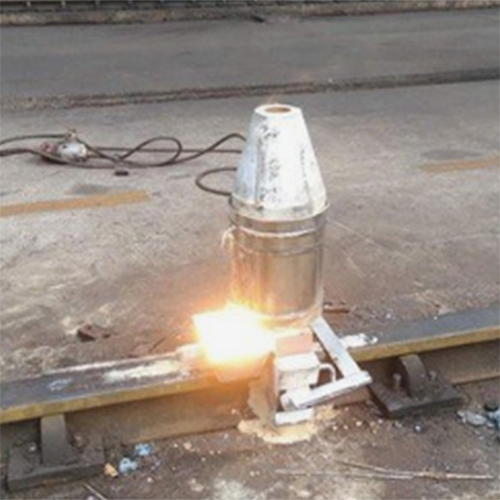Product Description
Thermite welding, also known as aluminothermic welding, is a specialized welding process used to join metal components, particularly rails in railway tracks. It is a highly efficient and reliable method of creating strong, permanent welds between two pieces of metal.
Here's how thermite welding works:
-
1.Preparation: The two metal components to be welded, typically rail ends, are cleaned and prepared by removing any contaminants, oxides, or paint. The rail ends are shaped and aligned to ensure proper fit and contact during the welding process.
-
2.Thermite Mixture: A thermite mixture is prepared using a powdered metal fuel (usually aluminum) and a metal oxide (typically iron oxide, known as rust). The mixture is carefully proportioned and compacted into a mold called a crucible.
-
3.Ignition: A high-temperature ignition source, such as a magnesium ribbon, is used to ignite the thermite mixture inside the crucible.
-
4.Exothermic Reaction: The ignition triggers an exothermic chemical reaction known as the thermite reaction. The aluminum fuel reduces the metal oxide, resulting in the release of a tremendous amount of heat. The reaction is highly exothermic and self-sustaining.
-
5.Molten Metal Formation: The intense heat generated by the thermite reaction melts the metal oxide and the aluminum fuel. This forms a pool of molten metal, primarily consisting of iron from the metal oxide and aluminum from the fuel.
-
6.Weld Formation: The molten metal pool is poured or guided into a pre-positioned mold or gap between the rail ends. The molten metal fills the gap, completely surrounding and joining the rail ends.
-
7.Solidification: The molten metal cools and solidifies, forming a strong weld joint between the rail ends. The resulting weld is typically free of defects and has excellent metallurgical properties.
Thermite welding offers several advantages:
-
1.Strength and Durability: Thermite welds are known for their high strength and durability. The process creates a homogeneous and metallurgically sound weld joint, often stronger than the parent material.
-
2.Cost-Effective: Thermite welding is a cost-effective method for joining rails. It requires minimal equipment and can be performed in situ, reducing the need for extensive dismantling and transport of rails.
-
3.Longevity: Thermite welds have a long service life, as they are resistant to fatigue, wear, and environmental factors.
-
4.Low Maintenance: Once thermite welding is completed, the resulting weld joint requires minimal maintenance compared to other joining methods.
Thermite welding is primarily used in railway track construction and maintenance, where it provides a reliable and efficient method of joining rails. It is also utilized in specialized applications, such as welding copper conductors and joining other large metal components where high strength and durability are required.
It is worth noting that thermite welding is a specialized process that requires skilled personnel and adherence to strict safety protocols due to the high temperatures and potential hazards involved.
Characteristics of thermite welding
Thermite welding, also known as aluminothermic welding, possesses several characteristic features that make it a preferred method for joining metal components, particularly in railway track construction. Here are some key characteristics of thermite welding:
-
1.High Strength: Thermite welds are known for their exceptional strength. The process creates a metallurgical bond between the metal components being joined, resulting in a weld joint that is often stronger than the parent material. This high strength is vital for applications such as railway tracks, where the welds must withstand heavy loads and constant vibration.
-
2.Metallurgical Integrity: Thermite welding produces a weld joint with excellent metallurgical integrity. The process allows for the fusion of the base metals without the addition of filler material. This results in a homogeneous weld joint with a consistent microstructure and chemical composition, minimizing the risk of defects or weak points in the weld.
-
3.Minimal Heat-Affected Zone (HAZ): Thermite welding generates an intense localized heat that is focused on the weld area. As a result, the heat-affected zone, which is the area surrounding the weld joint that undergoes thermal changes, is relatively small. This characteristic helps to minimize the potential for distortion or damage to the surrounding material.
-
4.Low Hydrogen Content: Thermite welding produces welds with low hydrogen content. This is particularly important in applications where hydrogen-induced cracking is a concern. By minimizing the hydrogen content, thermite welding helps to prevent the formation of cracks and ensures the integrity of the weld joint.
-
5.Longevity and Durability: Thermite welds are known for their longevity and durability. They exhibit excellent resistance to fatigue, wear, and environmental factors, making them suitable for applications where the welds need to withstand harsh conditions and long service lives.
-
6.Simplicity and Portability: Thermite welding is a relatively simple process that requires minimal equipment. The equipment used, such as the crucible and ignition source, is portable, allowing the welding process to be carried out in situ. This feature reduces the need for extensive dismantling and transportation of large metal components, making thermite welding a cost-effective and efficient joining method.
-
7.Versatility: Thermite welding can be used to join a wide range of metals, including steel, cast iron, and some non-ferrous metals. This versatility makes it suitable for various applications beyond railway track construction, such as joining copper conductors and other large metal components.
While thermite welding offers numerous advantages, it is worth noting that the process requires skilled personnel and strict adherence to safety protocols due to the high temperatures involved. Additionally, the equipment and materials used in thermite welding must meet specific quality standards to ensure reliable and consistent welds.
 English
English  Español
Español  Português
Português  русский
русский  français
français  日本語
日本語  Deutsch
Deutsch  Tiếng Việt
Tiếng Việt  Italiano
Italiano  Nederlands
Nederlands  ไทย
ไทย  Polski
Polski  한국어
한국어  Svenska
Svenska  magyar
magyar  Malay
Malay  বাংলা
বাংলা  Dansk
Dansk  Suomi
Suomi  हिन्दी
हिन्दी  Pilipino
Pilipino  Türk
Türk  Gaeilge
Gaeilge  عربى
عربى  norsk
norsk  اردو
اردو  čeština
čeština  Ελληνικά
Ελληνικά  Українська
Українська  Javanese
Javanese  فارسی
فارسی  தமிழ்
தமிழ்  తెలుగు
తెలుగు  नेपाली
नेपाली  Burmese
Burmese  ລາວ
ລາວ  Қазақ
Қазақ  Euskal
Euskal  slovenský
slovenský  Македонски
Македонски  Română
Română  Српски
Српски  简体中文
简体中文  Afrikaans
Afrikaans  עִברִית
עִברִית  יידיש
יידיש  Беларус
Беларус  മലയാളം
മലയാളം  Hawaiian
Hawaiian  հայերեն
հայերեն 










